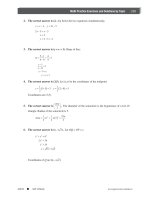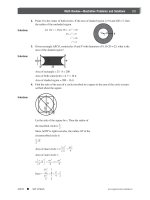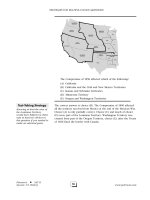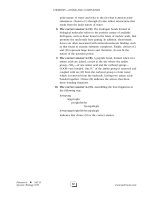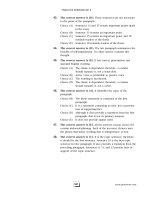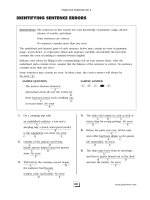New SAT Writing Workbook Episode 1 Part 4 ppt
Bạn đang xem bản rút gọn của tài liệu. Xem và tải ngay bản đầy đủ của tài liệu tại đây (103.65 KB, 25 trang )
PRACTICE ESSAY 4
Directions: Think carefully about the issue described in the excerpt
below and about the assignment that follows it.
Odd as it may sound, personality is a skill. You can choose and
develop aspects of it that will draw people to you and make them
want to help you learn and improve.
—Twyla Tharp, The Creative Habit: Learn It and Use It for Life
Assignment: What is your opinion of the idea that a person can
choose and develop personality traits that will attract others or turn
them away? Plan and write an essay that develops your point of view
on the issue. Support your opinion with reasoning and examples
from your reading, your classwork, your personal experiences, or
your observations.
PART I: PRACTICING YOUR ESSAY WRITING SKILLS
66
www.petersons.com
PRACTICE ESSAY 4
Follow these steps to writing your essay.
TIP Set aside 5 minutes for Steps 1 through 5.
Step 1 Read the question carefully.
Step 2 Restate to yourself what the question is asking. Underline the key words.
Step 3 Make a list by brainstorming all the ideas that come to mind. Write your ideas in the space
below.
CHAPTER 4: WRITING PRACTICE ESSAYS
67
www.petersons.com
Step 4 Create a thesis from the ideas you brainstormed.
Step 5 Turn your brainstorm into an informal working plan by numbering the items that you want
to include in your essay in the order in which you want to include them. Cross out ideas
that no longer fit now that you have a thesis statement.
TIP
Take 3 minutes to write your introductory paragraph. You want to be sure
that you are writing a clearly stated and interesting introduction.
Step 6 Begin writing your introduction by stating your thesis clearly.
Step 7 Read your first paragraph to be sure that the ideas you used follow each other logically and
support your thesis.
PART I: PRACTICING YOUR ESSAY WRITING SKILLS
68
www.petersons.com
TIP
By now you should be about 8 minutes into the 20 minutes you have to
write your essay. Have you finished the first paragraph? You want to leave
2 minutes at the end for proofreading and r evising.
Step 8 Check your quick list of ideas. Choose the next idea and write a transition into your second
paragraph. Keep writing until you use all the RELEVANT ideas on your quick list.
TIP
Don’t forget to use
transitions between
your paragraphs.
TIP
If a new idea comes
from the flow of
your writing, use it
IF IT FITS THE CON-
TEXT.
CHAPTER 4: WRITING PRACTICE ESSAYS
69
www.petersons.com
TIP
You should have about 6 minutes of your writing time left. How much
time do you have?
Step 9 Allow about 4 minutes to write a solid conclusion using one of the following methods:
• Rephrase your thesis.
• Summarize your main points.
• Refer in some way back to your introductory
paragraph.
TIP
You should have paced yourself so that you have 2 minutes for your final
review.
Step 10 Proofread and revise neatly.
• Cross out any irrelevant ideas or words.
• Make any additions, especially transitions.
• Smooth out any awkward sentences.
• Check your grammar and mechanics.
PART I: PRACTICING YOUR ESSAY WRITING SKILLS
70
www.petersons.com
SELF-EVALUATION RUBRIC
654321
Overall
Impression
Demonstrates excel-
lent command of
the conventions of
English; outstanding
writing compe-
tence; thorough and
effective; incisive
Demonstrates good
command of the
conventions of En-
glish; good writing
competence; less
thorough and inci-
sive than the highest
essays
Demonstrates ad-
equate command of
the conventions of
English; competent
writing
Demonstrates fair
command of the
conventions of
English; some writ-
ing competency
Demonstrates little
command of the
conventions of
English; poor writ-
ing skills; unaccept-
ably brief; fails to
respond to the ques-
tion
Lacking skill and
competence
Thesis
and Purpose
Exhibits excellent
perception and clar-
ity; original, interest-
ing, or unique ap-
proach; includes apt
and specific refer-
ences, facts, and/or
examples
Exhibits good per-
ception and clarity;
engaging approach;
includes specific
references, facts,
and/or examples
Clear and percep-
tive; somewhat in-
teresting; includes
references, facts,
and/or examples
Somewhat clear but
exhibits incomplete
or confused think-
ing; dull, mechani-
cal, overgeneralized
Very little clarity;
confusing; flawed
logic
Very confusing or
completely off the
topic
Organization
and Development
Meticulously orga-
nized and thor-
oughly developed;
coherent and uni-
fied
Well organized and
developed; coherent
and unified
Reasonably orga-
nized and devel-
oped; generally co-
herent and unified
Moderately orga-
nized and devel-
oped; some incoher-
ence and lack of
unity
Little or no organiza-
tion and develop-
ment; incoherent
and void of unity
No apparent organi-
zation or develop-
ment; incoherent
Use of
Sentences
Effectively varied
and engaging; virtu-
ally error free
Varied and interest-
ing; a few errors
Adequately varied;
some errors
Moderately varied
and marginally inter-
esting; one or more
major errors
Little or no varia-
tion; dull and unin-
teresting; some
major errors
Numerous major
errors
Word
Choice
Interesting and ef-
fective; virtually
error free
Generally interest-
ing and effective; a
few errors
Occasionally inter-
esting and effective;
several errors
Moderately dull and
ordinary; some er-
rors in diction
Mostly dull and con-
ventional; numerous
errors
Numerous major
errors; extremely
immature
Grammar
and Usage
Virtually error free Occasional minor
errors
Some minor errors Some major errors Severely flawed;
frequent major
errors
Extremely flawed
CHAPTER 4: WRITING PRACTICE ESSAYS
71
www.petersons.com
Instructions: Rate yourself in each of the categories on the rubric. Circle the description in
each category that most accurately reflects your performance. Enter the numbers on the lines
below. Then calculate the average of the six numbers to determine your final score. On the SAT
I, at least two readers will rate your essay on a scale of 1 to 6, with 6 being the highest. Because
it is difficult to score yourself objectively, you may wish to ask a respected friend or teacher to
assess your writing to reflect more accurately its effectiveness.
SELF-EVALUATION
Each category is rated 6 (high) to 1 (low)
Overall Impression
Thesis and Purpose
Organization and Development
Use of Sentences
Word Choice
Grammar and Usage
TOTAL
Divide by 6 for final score
OBJECTIVE EVALUATION
Each category is rated 6 (high) to 1 (low)
Overall Impression
Thesis and Purpose
Organization and Development
Use of Sentences
Word Choice
Grammar and Usage
TOTAL
Divide by 6 for final score
PART I: PRACTICING YOUR ESSAY WRITING SKILLS
72
www.petersons.com
PRACTICE ESSAY 5
Directions: Think carefully about the issue described in the excerpt
below and about the assignment that follows it.
Webster’s dictionary defines perfectionism “as an extreme or obses-
sive striving for perfection.” Some people believe that perfectionism
inhibits a person’s ability to work productively and well. Some
colleges and universities have been sending their students the
message to take things less seriously and to enjoy their college years
more.
Assignment: What is your view of the message to college students to
relax a little? Plan and write an essay that develops your point of
view on the issue. Support your opinion with reasoning and ex-
amples from your reading, your classwork, your personal experiences,
or your observations.
CHAPTER 4: WRITING PRACTICE ESSAYS
73
www.petersons.com
PRACTICE ESSAY 5
Follow these steps to writing your essay.
TIP Set aside 5 minutes for Steps 1 through 5.
Step 1 Read the question carefully.
Step 2 Restate to yourself what the question is asking. Underline the key words.
Step 3 Make a list by brainstorming all the ideas that come to mind. Write your ideas in the space
below.
PART I: PRACTICING YOUR ESSAY WRITING SKILLS
74
www.petersons.com
Step 4 Create a thesis from the ideas you brainstormed.
Step 5 Turn your brainstorm into an informal working plan by numbering the items that you want
to include in your essay in the order in which you want to include them. Cross out ideas
that no longer fit now that you have a thesis statement.
TIP
Take 3 minutes to write your introductory paragraph. You want to be sure
that you are writing a clearly stated and interesting introduction.
Step 6 Begin writing your introduction by stating your thesis clearly.
Step 7 Read your first paragraph to be sure that the ideas you used follow each other logically and
support your thesis.
CHAPTER 4: WRITING PRACTICE ESSAYS
75
www.petersons.com
TIP
By now you should be about 8 minutes into the 20 minutes you have to
write your essay. Have you finished the first paragraph? You want to leave
2 minutes at the end for proofreading and r evising.
Step 8 Check your quick list of ideas. Choose the next idea and write a transition into your second
paragraph. Keep writing until you use all the RELEVANT ideas on your quick list.
TIP
Don’t forget to use
transitions between
your paragraphs.
TIP
If a new idea comes
from the flow of
your writing, use it
IF IT FITS THE CON-
TEXT.
PART I: PRACTICING YOUR ESSAY WRITING SKILLS
76
www.petersons.com
TIP
You should have about 6 minutes of your writing time left. How much
time do you have?
Step 9 Allow about 4 minutes to write a solid conclusion using one of the following methods:
• Rephrase your thesis.
• Summarize your main points.
• Refer in some way back to your introductory
paragraph.
TIP
You should have paced yourself so that you have 2 minutes for your final
review.
Step 10 Proofread and revise neatly.
• Cross out any irrelevant ideas or words.
• Make any additions, especially transitions.
• Smooth out any awkward sentences.
• Check your grammar and mechanics.
CHAPTER 4: WRITING PRACTICE ESSAYS
77
www.petersons.com
SELF-EVALUATION RUBRIC
654321
Overall
Impression
Demonstrates excel-
lent command of
the conventions of
English; outstanding
writing compe-
tence; thorough and
effective; incisive
Demonstrates good
command of the
conventions of En-
glish; good writing
competence; less
thorough and inci-
sive than the highest
essays
Demonstrates ad-
equate command of
the conventions of
English; competent
writing
Demonstrates fair
command of the
conventions of
English; some writ-
ing competency
Demonstrates little
command of the
conventions of
English; poor writ-
ing skills; unaccept-
ably brief; fails to
respond to the ques-
tion
Lacking skill and
competence
Thesis
and Purpose
Exhibits excellent
perception and clar-
ity; original, interest-
ing, or unique ap-
proach; includes apt
and specific refer-
ences, facts, and/or
examples
Exhibits good per-
ception and clarity;
engaging approach;
includes specific
references, facts,
and/or examples
Clear and percep-
tive; somewhat in-
teresting; includes
references, facts,
and/or examples
Somewhat clear but
exhibits incomplete
or confused think-
ing; dull, mechani-
cal, overgeneralized
Very little clarity;
confusing; flawed
logic
Very confusing or
completely off the
topic
Organization
and Development
Meticulously orga-
nized and thor-
oughly developed;
coherent and uni-
fied
Well organized and
developed; coherent
and unified
Reasonably orga-
nized and devel-
oped; generally co-
herent and unified
Moderately orga-
nized and devel-
oped; some incoher-
ence and lack of
unity
Little or no organiza-
tion and develop-
ment; incoherent
and void of unity
No apparent organi-
zation or develop-
ment; incoherent
Use of
Sentences
Effectively varied
and engaging; virtu-
ally error free
Varied and interest-
ing; a few errors
Adequately varied;
some errors
Moderately varied
and marginally inter-
esting; one or more
major errors
Little or no varia-
tion; dull and unin-
teresting; some
major errors
Numerous major
errors
Word
Choice
Interesting and ef-
fective; virtually
error free
Generally interest-
ing and effective; a
few errors
Occasionally inter-
esting and effective;
several errors
Moderately dull and
ordinary; some er-
rors in diction
Mostly dull and con-
ventional; numerous
errors
Numerous major
errors; extremely
immature
Grammar
and Usage
Virtually error free Occasional minor
errors
Some minor errors Some major errors Severely flawed;
frequent major
errors
Extremely flawed
PART I: PRACTICING YOUR ESSAY WRITING SKILLS
78
www.petersons.com
Instructions: Rate yourself in each of the categories on the rubric. Circle the description in
each category that most accurately reflects your performance. Enter the numbers on the lines
below. Then calculate the average of the six numbers to determine your final score. On the SAT
I, at least two readers will rate your essay on a scale of 1 to 6, with 6 being the highest. Because
it is difficult to score yourself objectively, you may wish to ask a respected friend or teacher to
assess your writing to reflect more accurately its effectiveness.
SELF-EVALUATION
Each category is rated 6 (high) to 1 (low)
Overall Impression
Thesis and Purpose
Organization and Development
Use of Sentences
Word Choice
Grammar and Usage
TOTAL
Divide by 6 for final score
OBJECTIVE EVALUATION
Each category is rated 6 (high) to 1 (low)
Overall Impression
Thesis and Purpose
Organization and Development
Use of Sentences
Word Choice
Grammar and Usage
TOTAL
Divide by 6 for final score
CHAPTER 4: WRITING PRACTICE ESSAYS
79
www.petersons.com
Chapter 5
THE TOP 10 RULES OF EFFECTIVE
WRITING
Your goals for this chapter are to
• Learn 10 important rules for making your writing effective
• Practice these 10 rules to become confident in your writing
What is effective writing? Effective writing is writing that gets your
point across clearly and concisely. It accomplishes the purpose you
have established for your piece—to explain, to entertain, or, in the
case of the SAT I essay, to persuade.
When you write, you have to make choices about the content,
organization, structure, and word usage that will be appropriate for
the assignment. You must decide on the right words, the right
sentence structure, the right organizational style, and the right tone
for your purpose. As you gain knowledge about and experience in
good writing, your decisions become easier—and your writing
becomes more confident.
Before you reach the point where your choices come effortlessly
to you, you need to learn what makes a piece of writing effective.
You also need to think about how to create effective writing. This
chapter offers 10 rules that will help you make informed decisions for
effective writing. You will analyze and then practice
• Using action verbs and active voice
• Using precise words
• Saying exactly what you mean
• Maintaining consistent tone throughout a piece of writing
• Avoiding words that may not be understood
• Being concise in your development of ideas
• Improving sentences by combining or shortening sentences
• Developing sentence variety
• Using the conventions of standard written English for capitalization
and punctuation
80
These same rules apply when you have to answer the SAT’s multiple-
choice questions about improving sentences and paragraphs. The
practice you complete in this chapter will help you when you start to
work on Part II of this book.
USING THE PRACTICE ITEMS
After each rule, there is a set of practice items called Check Your
Writing Skills. The practice sentences for rules 9 and 10 about
capitalization and punctuation are combined at the end of rule 10.
Review the recommendations for creating effective writing that apply
for each rule and then read and complete each practice set. If you do
not understand what to do to fix or rewrite a particular sentence, you
may read the answer immediately.
On pages 113–124, there is a single set of 50 items. Before
reading and completing them, review the 10 rules for effective
writing. Then, complete the entire set of 50 items. Try not to check
the suggested responses until you have finished a group of sentences.
On page 128, you will find some additional suggestions for
practice. By practicing writing effectively now, you can gain confi-
dence for writing your SAT I essay.
RULE 1: USE ACTION VERBS AND THE ACTIVE VOICE
Your job as a writer is to communicate effectively with your reader.
To do this, you need to make your writing interesting. Using action
verbs and active voice adds life to writing.
ACTION VERBS
Action verbs in the active voice make your sentences vivid and easy
to understand. While parts of the verb to be, such as is or was, are
necessary for expressing some ideas, too many of them make your
writing dull. Wherever possible, replace the parts of the verb to be
with action verbs by
• Changing an important noun in a sentence into an action verb
Verb to be: The use of leaf blowers before 8 a.m. is a violation of
local noise abatement laws.
Action Verb: The use of leaf blowers before 8 a.m. violates local
noise abatement laws.
• Substituting a verb that has a meaning similar to that of one of the
important nouns or adjectives in the sentence
Verb to be: The quarterback’s wretched performance was a
disgrace to his team.
CHAPTER 5: THE TOP 10 RULES OF EFFECTIVE WRITING
81
www.petersons.com
Action Verb: The quarterback’s wretched performance humiliated
his team.
• Rephrasing your sentence if you can think of no related verbs
Verb to be: Jamie was happy to be part of the all-star soccer team.
Action Verb: Being a part of the all-star soccer team thrilled Jamie.
In the examples above, notice how the substitutions create more
interesting sentences. Replacing weak verbs with strong, precise
action verbs adds vitality to your writing.
CHOOSE THE ACTIVE VOICE
In addition to using action verbs, you can make your essay more
direct and more interesting by writing in the active voice. A verb is in
the active voice when its subject performs the action. Verbs in the
passive voice usually force your reader to wait until the end of the
sentence to find the doer, or the subject, of the action. Notice how
much more effective the sentences in active voice are in the follow-
ing examples.
Passive Voice: The main idea for my essay was stated as the
first sentence in the first paragraph.
Active Voice: I stated the main idea of my essay in the first
sentence in the first paragraph.
Passive Voice: Money for the new recreation building was
raised quickly.
Active Voice: The recreation committee quickly raised money
for the new building.
CHECK YOUR WRITING SKILLS
Rewrite each sentence, using an action verb in the active voice.
1. The completion of the homework assignment was immensely
pleasing to Tori.
PART I: PRACTICING YOUR ESSAY WRITING SKILLS
82
www.petersons.com
2. Laughing and joking was heard from the sailors as they scrubbed
the decks of the ship.
3. A study of the life cycles of various South American monkeys
was made by the zoologists.
4. Since Liz was pursuing her goal to be a physician, all her spare
time was spent studying.
5. The sounds that were made by the ghosts in the haunted house
were frightening to me.
RULE 2: USE PRECISE WORDS
When you write, use the most precise words you can to make your
ideas stand out. In addition to using action verbs in the active voice,
you make your writing clearer by using the most specific words
you can.
REPLACE OVERLY GENERAL WORDS WITH SPECIFIC IMAGES
Words with specific meanings will give your readers a mental picture
that allows them to see what you see and understand what you are
thinking. General words such as said or animal are useful but
sometimes fall short of expressing an idea clearly and may leave
readers uninformed. To communicate effectively, use specific nouns,
verbs, and modifiers. Notice how the following examples become
more interesting when specific verbs replace overly general ones.
General: Tom got into his car and drove off.
Specific: Tom leaped into his SUV and roared off.
CHAPTER 5: THE TOP 10 RULES OF EFFECTIVE WRITING
83
www.petersons.com
General: The writer wrote a three-page critique of the painting
in which he said he did not like it.
Specific: In his three-page critique, the art critic squeezed every
drop of meaning—and enjoyment—out of the 3-inch by 3-inch
pastel.
Overly general words about people, places, and things can leave your
readers wondering about details. Substitute specific nouns to clarify
your thoughts.
General: An old dog came up the street.
Specific: An ancient, gray-muzzled golden retriever wandered
up Bluebird Canyon Road.
General: My coach illustrates the point about playing fairly.
Specific: My basketball coach, Ms. Berry, illustrates the essayist’s
point about playing fairly.
You can further sharpen the meaning of your sentences by using
well-chosen, vivid adjectives and adverbs.
General: The Star Wars saga is an interesting group of movies.
Specific: The Star Wars saga is a memorable series of films,
filled with amazing aliens and noble heroes.
General: At the end of the day, the workmen walked up the
snow-covered road.
Specific: At the end of the day, the tired workmen trudged
wearily up the snow-covered road.
Vague modifiers, such as interesting and good, may show your
feelings and opinions, but more colorful modifiers add details that
help focus your writing, as well as show your opinions and feelings.
General: I thought the essay was well written and interesting.
Specific: I thought the writer effectively organized her essay to
move from the specific to the general.
CHOOSE THE RIGHT CONNOTATION
The denotation of a word is its literal meaning, whereas the connota-
tion is a broader area of meanings that a word suggests. Often, when
you are searching for a word, two or more possibilities occur to you.
Most probably, the words are synonyms. While the words have
definitions that are close in meaning, they neither share the same
precise meaning nor do they call the same ideas to mind. One
synonym probably has a different connotation, a different shade of
meaning, from the other. Choose the right word with the best
connotation for your essay. By choosing the right shade of meaning,
PART I: PRACTICING YOUR ESSAY WRITING SKILLS
84
www.petersons.com
you can present your ideas more precisely. Consider the following
examples:
• Claire was crafty, and she would distract her mother so that her
dog could sneak snacks off the dinner table.
(Crafty has the negative connotation of deception.)
• Claire was shrewd, and she would distract her mother so that her
dog could sneak snacks off the dinner table.
(Shrewd can also have a negative connotation, but it can also mean
skill in practical matters.)
• Claire was clever, and she would distract her mother so that her
dog could sneak snacks off the dinner table.
(Clever has a more positive connotation than the other words. It
suggests Claire’s actions are harmless and playful instead of
secretive and deceptive.)
Choose the word with the most appropriate connotation, depending
on the ideas you want to communicate. The best way to learn word
connotations and denotations is to read widely. Use a thesaurus and a
dictionary to look up the meanings of words to help you see the
subtle difference between meanings of similar words.
CHECK YOUR WRITING SKILLS
For sentences 6 through 8, rewrite the sentences, using more specific
verbs, nouns, and modifiers.
6. The soccer players worked hard for a goal.
7. I enjoyed my United States history class because Ms. Lim made it
interesting.
8. Tom brought the huge fish over the side of the boat.
CHAPTER 5: THE TOP 10 RULES OF EFFECTIVE WRITING
85
www.petersons.com
For sentences 9 and 10, rewrite the sentences, substituting a syn-
onym with a different connotation for the italicized word.
9. Eva seems cold to people who do not know her.
10. The politician preached against the dangers of unlimited wet-
lands development.
RULE 3: SAY WHAT YOU MEAN
Be careful to avoid clichés, trite expressions, and euphemisms in your
writing. Including overused clichés and trite expressions in your
writing makes you appear lazy because you haven’t taken the time
and effort to express your exact meaning. In addition, trite expres-
sions don’t give your audience a clear idea of what you mean. Using
details will do that. Euphemisms can lead to wordiness and make
your writing stilted.
To help you avoid clichés and trite expressions, start a Word
Bank of words and phrases that you could use in writing the kinds of
essays that the College Board asks for on the SAT I Writing test.
PART I: PRACTICING YOUR ESSAY WRITING SKILLS
86
www.petersons.com
REPLACE CLICHÉS WITH FRESHER IMAGES AND WORDS
A cliché is any stale, worn-out phrase that has been used so often it
has become virtually meaningless. Clichés make your writing seem
commonplace and secondhand. Some clichés and trite expressions
include the following:
Ugly as sin Like finding a needle in a
haystack
Pretty as a picture Like a bump on a log
Happy as a lark Like a hot potato
Hard as a rock Sky high
Fresh as a daisy Sparkling clean
Skinny as a rail Filthy rich
Sly as a fox Dirt cheap
Stiff as a board Costing an arm and a leg
Old as the hills Heart of gold
Mad as a hornet One in a million
Soft as silk Between a rock and a hard
place
Warm as toast Out of the frying pan and
into the fire
Dumb as a doorknob When push comes to shove
Smart as a whip Working fingers to the bone
Crazy as a loon Come out smelling like a rose
Honest as the day is long Tooting my/your/one’s own
horn
As much fun as a barrel of monkeys In a New York minute
Quiet as a mouse Variety is the spice of life.
Loose as a goose Stand up and be counted
Phony as a three-dollar bill Raining cats and dogs
Pure as the driven snow The sixty-four dollar question
Crystal clear Day in and day out
True blue Have a nice day
Like pulling teeth Like a fish out of water
Replace clichés and trite expressions with livelier, more concrete
language. For example:
Cliché: I was shaking in my boots before the interview, but I
was happy as a lark when the personnel manager offered me
the job.
Improved: I was terrified before the interview, but I was
ecstatic when the personnel manager offered me the job.
CHAPTER 5: THE TOP 10 RULES OF EFFECTIVE WRITING
87
www.petersons.com
Cliché: Whether the author really believed what he wrote was
the sixty-four dollar question.
Improved: Whether the author really believed what he wrote
was difficult to determine from the answers he gave the inter-
viewer.
AVOID EUPHEMISMS
A euphemism is a word or phrase that is less direct but that may be
considered less offensive than another word or phrase with the same
meaning; for example, saying someone is no longer with us instead
of dead. Euphemisms can lead to wordiness, as in the above ex-
ample, because you may need several words to say what one direct
word could convey. Euphemisms also lessen the impact of a thought
or idea, and they can mislead your readers. Occasionally, you may
choose to use a euphemism to protect someone’s feelings—yours, the
subject of your writing’s, or your audience’s—but eliminate euphe-
misms whenever possible, so your writing does not seem insincere.
Euphemism: Amit could not attend the meeting Thursday
because he was indisposed.
Improved: Amit could not attend the meeting Thursday because
he was sick.
Euphemism: Because she was constantly late for work, Leslie
was let go.
Improved: Because she was constantly late for work, Leslie was
fired.
CHECK YOUR WRITING SKILLS
For sentences 11 through 13, rewrite the sentences, replacing the
italicized clichés with more interesting language.
11. I tried to start my car, but the battery was dead as a doornail.
12. Ms. Lim is a one-in-a-million teacher.
PART I: PRACTICING YOUR ESSAY WRITING SKILLS
88
www.petersons.com
13. Every time I have to make a presentation in class, my stomach
gets tied up in knots.
For sentences 14 and 15, rewrite the sentences, replacing the
italicized euphemisms with more precise words.
14. Marli’s room was in a state of severe disorder.
15. One of Armando’s weekly chores was to eliminate the refuse.
RULE 4: MAINTAIN YOUR TONE
The words you choose express your attitude—feelings and opin-
ions—about the subject of your essay. This attitude is called tone.
Good writers maintain a consistent tone about their subject. As you
begin to write a paper, choose a tone that is appropriate for your
topic, audience, and purpose and then pick words to fit that tone.
Maintain the same tone throughout whatever you are writing,
whether it is the SAT I essay, your college application essay, or a
research report. The right tone for your SAT I essay is the same tone
you use in writing an essay for class. Just as clichés and euphemisms
reduce the effectiveness of your writing, so, too, can inappropriate
word choice by confusing the tone.
AVOID SELF-IMPORTANT LANGUAGE
If a writer tries to impress readers with unnecessarily obscure words
and lengthy, complicated sentences, that author has used self-
important language. The result can destroy the tone and confuse the
message. When you write, avoid that type of language. Eliminate
vague, general nouns and long verbs that end in -ate or -ize.
Self-important: To facilitate input by the maximum number of
potential purchasers, questionnaires were designed and posted
well in advance of the launch of the promotional marketing
campaign.
CHAPTER 5: THE TOP 10 RULES OF EFFECTIVE WRITING
89
www.petersons.com
Improved: Before we began advertising, we designed and
mailed a marketing survey to find out what customers were
looking for.
AVOID FLOWERY LANGUAGE AND EMOTIONALLY LOADED WORDS
Good writing should include vivid modifiers and interesting phrases.
However, your writing should never become overloaded with
unnecessary adjectives and adverbs that serve only as decoration.
Usually, a simpler way of expressing yourself is more effective.
Flowery: The glimmering, golden rays of the brilliant orb of the
sun shimmered above the white-hot sands of the vast desert,
sere and lifeless.
Improved: The rays of the sun shimmered above the hot, dry
desert.
Similarly, overly emotional language can produce a harsh tone and
make your readers reject your point of view. Avoid emotional
language and substitute more rational diction.
Emotional: The idiot who wrote that essay should have his
head examined.
Improved: The writer who developed that argument based it
on a faulty assumption.
CHECK YOUR WRITING SKILLS
For sentences 16 through 18, rewrite the sentences, replacing
self-important language with precise, direct language.
16. To develop an appropriate level of competency, users of the
paintbrush practice their art endlessly.
17. Luis tried to ameliorate his grade by fawning over his teacher.
18. In my opinion, the author penned a brilliant and incandescent
essay illuminating and extolling the multiplicity of benefits to be
derived from a post-prandial nap.
PART I: PRACTICING YOUR ESSAY WRITING SKILLS
90
www.petersons.com


